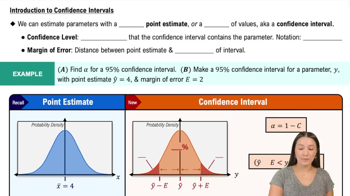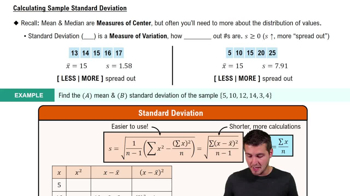Atkins Weight Loss Program In a test of weight loss programs, 40 adults used the Atkins weight loss program. After 12 months, their mean weight loss was found to be 2.1 lb, with a standard deviation of 4.8 lb. Construct a 90% confidence interval estimate of the mean weight loss for all such subjects. Does the Atkins program appear to be effective? Does it appear to be practical?
Table of contents
- 1. Intro to Stats and Collecting Data1h 14m
- 2. Describing Data with Tables and Graphs1h 55m
- 3. Describing Data Numerically2h 5m
- 4. Probability2h 16m
- 5. Binomial Distribution & Discrete Random Variables3h 6m
- 6. Normal Distribution and Continuous Random Variables2h 11m
- 7. Sampling Distributions & Confidence Intervals: Mean3h 23m
- Sampling Distribution of the Sample Mean and Central Limit Theorem19m
- Distribution of Sample Mean - Excel23m
- Introduction to Confidence Intervals15m
- Confidence Intervals for Population Mean1h 18m
- Determining the Minimum Sample Size Required12m
- Finding Probabilities and T Critical Values - Excel28m
- Confidence Intervals for Population Means - Excel25m
- 8. Sampling Distributions & Confidence Intervals: Proportion1h 12m
- 9. Hypothesis Testing for One Sample3h 29m
- 10. Hypothesis Testing for Two Samples4h 50m
- Two Proportions1h 13m
- Two Proportions Hypothesis Test - Excel28m
- Two Means - Unknown, Unequal Variance1h 3m
- Two Means - Unknown Variances Hypothesis Test - Excel12m
- Two Means - Unknown, Equal Variance15m
- Two Means - Unknown, Equal Variances Hypothesis Test - Excel9m
- Two Means - Known Variance12m
- Two Means - Sigma Known Hypothesis Test - Excel21m
- Two Means - Matched Pairs (Dependent Samples)42m
- Matched Pairs Hypothesis Test - Excel12m
- 11. Correlation1h 6m
- 12. Regression1h 50m
- 13. Chi-Square Tests & Goodness of Fit1h 57m
- 14. ANOVA1h 57m
7. Sampling Distributions & Confidence Intervals: Mean
Confidence Intervals for Population Mean
Problem 7.2.17
Textbook Question
Genes Samples of DNA are collected, and the four DNA bases of A, G, C, and T are coded as 1, 2, 3, and 4, respectively. The results are listed below. Construct a 95% confidence interval estimate of the mean. What is the practical use of the confidence interval?
2 2 1 4 3 3 3 3 4 1
 Verified step by step guidance
Verified step by step guidance1
Step 1: Calculate the sample mean (\( \bar{x} \)) of the given data. Add all the values in the dataset (2, 2, 1, 4, 3, 3, 3, 3, 4, 1) and divide by the total number of observations (n = 10). The formula is \( \bar{x} = \frac{\sum x_i}{n} \).
Step 2: Calculate the sample standard deviation (s). Use the formula \( s = \sqrt{\frac{\sum (x_i - \bar{x})^2}{n-1}} \), where \( x_i \) represents each data point, \( \bar{x} \) is the sample mean, and \( n \) is the sample size.
Step 3: Determine the critical value (t*) for a 95% confidence level. Since the sample size is small (n = 10), use the t-distribution table with degrees of freedom \( df = n - 1 \) (in this case, \( df = 9 \)). Look up the t-value corresponding to a 95% confidence level.
Step 4: Calculate the margin of error (ME) using the formula \( ME = t^* \cdot \frac{s}{\sqrt{n}} \), where \( t^* \) is the critical value, \( s \) is the sample standard deviation, and \( n \) is the sample size.
Step 5: Construct the confidence interval. The 95% confidence interval is given by \( \bar{x} \pm ME \), where \( \bar{x} \) is the sample mean and \( ME \) is the margin of error. Interpret the interval in the context of the problem, explaining that it provides a range of plausible values for the true mean of the DNA base codes.
 Verified video answer for a similar problem:
Verified video answer for a similar problem:This video solution was recommended by our tutors as helpful for the problem above
Video duration:
4mPlay a video:
Was this helpful?
Key Concepts
Here are the essential concepts you must grasp in order to answer the question correctly.
Confidence Interval
A confidence interval is a range of values, derived from sample statistics, that is likely to contain the true population parameter with a specified level of confidence, typically 95%. It provides an estimate of uncertainty around the sample mean, indicating how much the sample mean might vary from the actual population mean.
Recommended video:

Introduction to Confidence Intervals
Sample Mean
The sample mean is the average of a set of values collected from a sample, calculated by summing all the sample values and dividing by the number of observations. It serves as a point estimate of the population mean and is crucial for constructing confidence intervals.
Recommended video:

Sampling Distribution of Sample Proportion
Standard Deviation
Standard deviation is a measure of the amount of variation or dispersion in a set of values. In the context of confidence intervals, it helps quantify the variability of the sample data, which is essential for determining the width of the confidence interval and thus the precision of the estimate.
Recommended video:
Guided course

Calculating Standard Deviation

 4:48m
4:48mWatch next
Master Population Standard Deviation Known with a bite sized video explanation from Patrick
Start learningRelated Videos
Related Practice
Textbook Question
